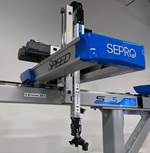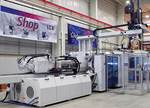Custom Automation for Stack Mold Applications
Wittmann has developed dual high-speed, top-entry robots to provide faster cycle times, lower payload requirements and flexible process flow in stack mold applications.
Injection molding machine, robot and auxiliary equipment supplier Wittmann USA, Torrington, Connecticut, has developed a custom robotics package targeting stack mold applications. Wittmann says applying dual high-speed top-entry robots can create cells with faster cycle times, lower payload requirements and flexible process flow.
Molders with stack mold applications have normally opted for dual vertical-arm robots to automate part handling, but Wittmann says these systems can lack the speed and payload required for the job.
In a release, Jason Long, VP of sales for Wittmann, related that many customers ask his company to quote dual vertical-arm robots for stack mold applications, but in most cases, Wittmann’s high-speed, top-entry robot cells have proven to be more robust and quicker for those applications.
Wittmann notes that its standard high-speed robots can be mounted to run even the most complex stack mold applications. These cells normally offer cycle times of seven to 12 seconds, without requiring special robots or causing abnormal wear and tear on dual vertical-arm robots, which can happen for robots not designed for quicker cycles.
In terms of flexibility, the cell can also be designed with different mounting stands to enable smaller footprints, integrated conveyor systems or other downstream equipment for premolding or postmolding automation. The robots can be programmed to work together or can run individually, where one robot can be used when standard two-plate molds are run in the same machine.

Wittmann is designing dual high-speed, top-entry robots systems for stack mold applications.
Source: Wittmann
Related Content
-
Understanding the Effect of Pressure Losses on Injection Molded Parts
The compressibility of plastics as a class of materials means the pressure punched into the machine control and the pressure the melt experiences at the end of fill within the mold will be very different. What does this difference mean for process consistency and part quality?
-
Process Monitoring or Production Monitoring — Why Not Both?
Molders looking to both monitor an injection molding process effectively and manage production can definitely do both with tools available today, but the question is how best to tackle these twin challenges.
-
Back to Basics on Mold Venting (Part 2: Shape, Dimensions, Details)
Here’s how to get the most out of your stationary mold vents.







